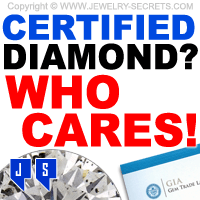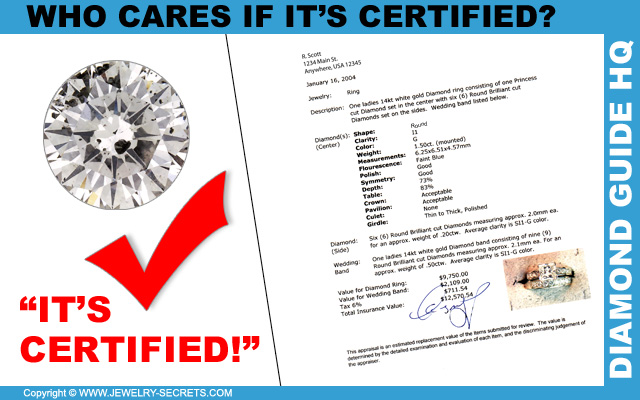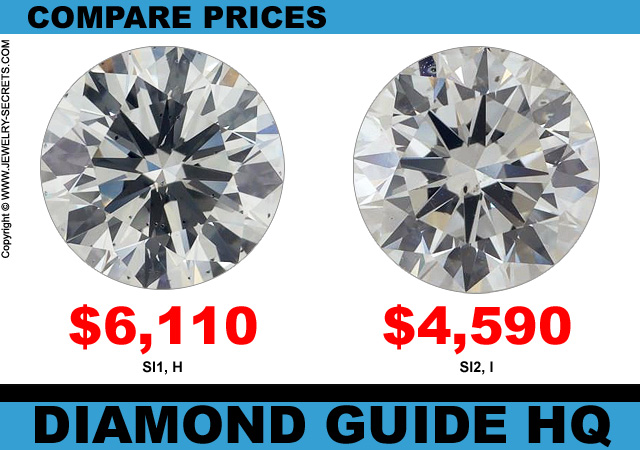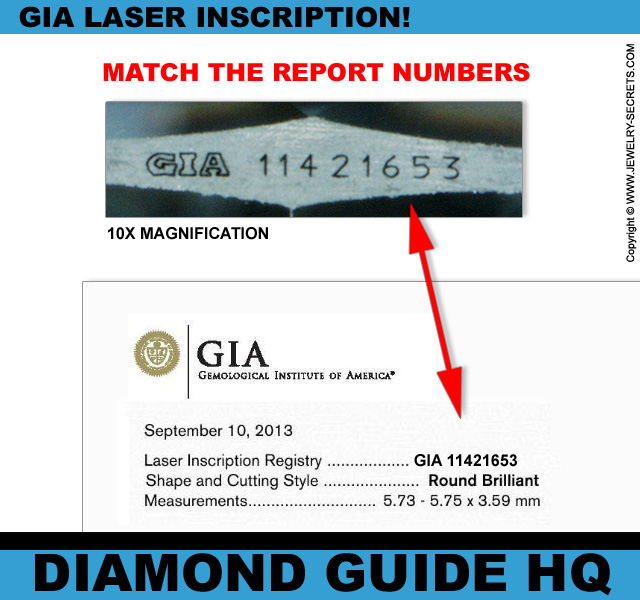THE DIAMOND IS CERTIFIED? WHO CARES!!!
LEARN WHY "CERTIFIED" DOESN'T MEAN GOOD QUALITY!
This post contains affiliate links. If you use these links to buy something I may earn a commission. Thanks! As an Amazon Associate I also earn from qualifying purchases.

I almost feel Sorry for Customers.
They can walk into any Jewelry Store across the country and see “Certified” Diamonds…
Customers know through public awareness (and web sources like mine), that if they’re buying a Diamond, they should always “MAKE SURE IT’S CERTIFIED!”
Why, television shows like 20/20 practically drill into their heads that in order to deter fraud and not get ripped off you should buy certified!
You hear it all the time!
“Make sure the stone is certified by an outside, independent source, that confirms the true quality of that Diamond!”
People now-a-days know that they should look for “Certified“, and by doing so, they believe that the Diamond is GOOD, and that they aren’t being mislead or taken.
So Are They?
YEP!
All the time!
Because often “Certified” really means nothing. Many times it’s just worthless paper, or even worse, a joke (“That’s an SI Clarity Stone???? HA!“)
Here’s why…
Diamond Quality
People think that if a Diamond is Certified, it must mean the Diamond Quality is GOOD. What they fail to realize is this: Any Diamond, of ANY Quality could be Certified!
So Jewelers could (and often do), take the lowest Clarity of Diamond there is (along with Low Color and Poor Cut as well), and certify them to make them look good. After all, Certified Diamonds DO appear better!
The public will see “Certified“, think they’re doing good, and buy them up like hot cakes.
It’s Such A Farce!
I always laugh when I see a certified Diamond that’s I Clarity! I Clarity IS the lowest Clarity Range there is! Do we really need to guarantee that you’re buying the lowest grade possible? NOPE!
It’s all done to look impressive and make the stone appear authentic and official!
But really, many are just low grade goods!
An acquaintance of mine went shopping around for Diamonds (I told her to), and she went into one Jewelry Store where the sales lady behind the counter began showing her stones. My friend asked her if the stone was a good stone, and the lady laughed and replied “Of course it is, it’s Certified!“

See what I mean!
It’s so wrong!
Don’t believe that just having a fancy laminated official-looking document means that the quality of the Diamond is good. Don’t be fooled! Many times it’s NOT!
Joe Schmoe Certified it!
Here’s something else that people don’t know: Anybody can Certify a Stone!
Anybody with any kind of credentials that is…
A Company, A Lab, A Jewelry Store, A Person… Anybody looking at the stone, can grade it and list that grade on paper.
It’s just someone saying “I believe the Clarity is ‘this’, the Color is ‘this’, the Cut is ‘this’, and here’s my signature and stamp of approval“!
And some Jewelry Stores do hire locals (they’re cheaper) to grade their stones. They could be a retired Diamontologist, an Amateur Gemologist, or just a simple Appraiser, but that doesn’t mean the grade is accurate. The people might not be a GIA Graduate… They could have graduated with just one semester of Gem Class in College…
Their equipment may be Cheap, Old, Out Dated, or not even be Calibrated right. The overhead lights could be wrong or dark… (you need Natural Northern Light to grade stones properly)… You just don’t know. For all we know, the grader’s eye sight might not be what is used to be???
All I’m saying is, there are thousands upon thousands of people and companies that can fill out a Diamond Report, Certify a Stone, and make it seem legit.
So it’s not just that a stone is Certified, it really comes down to: Who Certifies it!
Lax Gradings
Is a little flip phone from the 80’s on the same technically advanced platform as the latest iPhone?
Not by a long shot!
Neither is Diamond Grading Equipment. Some small labs aren’t as advanced as others. This could make their findings not so accurate. And, many companies own set of rules and regulations may not be as strict either.
A Black Spot in the center of a stone could be graded differently from lab to lab. “I think that’s an I1!” “I believe it’s an SI2!” “Nope, it’s an SI3!”
One company could be lax when it comes to “Near Colorless” stones (“It’s White when you view it from the top!“). While another could check them with Master Color Stones, and then double check them with a Diamond Colorimeter!
The point is, some company’s grades could be questionable!
I’ve seen some certified stones come from some companies that are way off mark. It makes me scratch my head and say “How did they come up with that?”
This is why it’s so important to have the most accurate grade you can get. Because an SI1, H Diamond is NOT the same price as an SI2, I… See below…

You could be paying hundreds or thousands more for one stone, thinking it’s one quality, when in fact it’s been bumped and something entirely different!
With certification, you want a strict company, with strict guidelines, and correct grades!
This is why you should stick with the best… And we’ll get to that in a moment…
Combining Stone Quality
This is something that I never understand. Some Certification Companies will grade an entire ring (versus just one stone), and combine all of the qualities together and list the entire range that they fall in. For example, they’ll say that the Clarity of the Diamonds is “SI1 – I1” (that’s a huge range), and the Color is (G-I).
I think listing quality like that is crazy. It sort of defeats the purpose of a Diamond Report.
You’ll look at a cert (certificate) like this, and then look at your ring, and still not know what the true Color or Clarity of the center stone is.
It could be SI1, G, It could be I1, I… AND THAT’S A BIG DIFFERENCE IN PRICE AND APPEARANCE!!!! (Doing a quick search on James Allen showed me there could be a $6,000 difference between an SI1, G, and an I1, I – OUCH!)
When you see a range of quality listed, versus just one Clarity and one Color (e.g. SI1, H), then I would always ALWAYS assume that the REAL quality of those stones is the lowest grade listed. In this case I would say they were I1, I. (Which is also what you should then be comparing versus SI1, G)!!!!!!!!
Saying they’re SI1-I1 makes it sound like you’re getting SI Goods! Wrongo! If you do, you’re the lucky one!
Ranges Suck!
I wouldn’t trust them, nor buy them!
Wait, What’s the Grade?
Some companies make up NEW GRADES that only confuse the public more. Grades that most Jewelry Stores don’t carry or sell. Grades like SI3!
If you go to a Jeweler, and look at their Diamond Chart, you won’t even see SI3 listed anywhere!
But yet, some Jewelers sell them!
BEWARE!
If you see a grade listed on a report, that isn’t a “normal” grade, then I would question that stone, and guess that the real quality is the quality below it. So an SI3 would in fact be an I1 instead (So Compare it to other I1’s as far as price goes, and not SI’s!)
The Certificate Is OLD!
Many Jewelers sell previously owned Diamonds, which is fine. Many of these stones come with old certificates (Graded in 1976 for example). This is also fine…
But here’s the deal…
That was (again, just using my example year) 38 years ago. And while it’s true that a Diamond’s Color or Clarity will never change or grow (they are timeless and forever after all), it’s not true that damage could have occurred to this stone which would drastically CHANGE it’s Appearance and VALUE!
Anything could have happened to that Diamond over the course of 38 years. And, if anything did, it wouldn’t be listed on the Report dated from 1976. That’s scary!
The Diamond could have been accidentally Chipped on the Girdle (a very common thing to happen). A new Chip, or Crack would change the Clarity and drop the Price of that Stone by THOUSANDS! (Chips, Cracks, Fractures, and Breaks are considered as Clarity)
The Diamond could not only have been Bumped and Chipped (“Thank You Filing Cabinet!“), but it could have also been Lasered (Laser Drilled, Filled, or Enhanced) to remove big ugly Flaws or sightly Inclusions (Maybe some Grandmother did this in 1999 and forgot to “update” the actual Certificate??? Would you know?)
The Culet of the Stone (the very bottom point of the Diamond) could have also been Chipped during setting… Or it could have been Bumped and Broken when it was removed from the mounting. Again, all of these damages would NOT be listed on the initial report. So you’ll look at the report, think the Diamond is GOOD, and it could be far from the truth! (So think about that when you buy Diamonds from people selling them on Craig’s List or eBay, as well as Antique Shops or Pawn Shops!)
If the Certificate is really OLD (like 10 years or more), it wouldn’t hurt to see if the store would send it back to the certificate company to “Confirm” that the original condition, is still the current condition (and update the certificate year as well).
Dollar Values
Certificates should do one thing, and one thing only: GRADE THE STONE!
But some companies take it one step farther, and they actually appraise the Diamond as well and add a Dollar Amount to that certificate!
I DON’T GET IT!
How can they put a price (now laminated forever) on a Diamond? They’re dictating what the value is and forcing companies to sell these stones at these prices for all time.
Not Cool!
Diamond Reports should have nothing to do with the actual VALUE! A Dollar Amount should never be listed on a Certificate!
Diamond Prices (just like Gold) fluctuate DAILY! The market goes up or down (This is why Rappaport comes out with a new price sheet every month – Rappaport is a Price List or Benchmark used by Dealers across the Country to Establish Diamond Prices).
Plus, many Diamonds increase in price due to inflation.
So how can one price stand the test of time?
It can’t!
Values should be saved for an Insurance Appraisal. Certificate Company’s should never have a hand in how much profit a Company, Jeweler, or Person could make off that stone. But these Certificate Company’s are cheaper to use, and loyalty and money does have a gentle way of swaying some Grades to be a little bit more favorable for the Jeweler involved! So why not?
Everyone wins, except for the consumer!
So if you see a Dollar Value listed on an actual Diamond Report… RUN!
Do They Match?
Many people shopping for Diamonds will look at the ring with their eyes from a distance of a foot away. They’ll put the ring on their finger and tilt it back and forth in the bright light to see it Sparkle and Dance. And then they’ll glance at the Certificate, hear a quick presentation from the sales clerk, and then buy the ring, and they’re out the door (none the wiser)…
They buy the Diamond without ever verifying the quality of that stone, or looking at it under a microscope!
So Sad!
How do you know that that particular stone goes with that particular report? YOU DON’T!
The Jeweler could give you ANY report, and say it goes with that stone, and you would never know.
That stone could have been accidentally switched while cleaning. It could have been purposefully swapped out so you get a much lower quality stone than expected, and they make more money.
So unless you actually microscope the stone under 10x magnification (which is what they use to grade stones with), and look at the Clarity, then you could be a potential victim for fraud.

I would not only advise you to look at the stone, view the Clarity, compare it to the Diamond Plot (if the Certificate has one), and ALSO compare that stone with OTHER similar quality stones, just to make sure that they look close enough alike.
This is IMPORTANT to do!
It only takes a few extra minutes, but it’s well worth the trip to the microscope. Every Jeweler has a 10x (or higher power) Microscope and I highly suggest you take a closer look. They’ll all let you, and most stores will be glad to show you and assist you.
Don’t be afraid to ASK!
Because staring at a Certificate, and making a solid decision based solely upon those facts and figures alone is NOT RECOMMENDED!
You MUST view the stone, magnified, with your very own eyes!
If not, you’re the only one to blame!
My Recommendation
I recommend that you buy GIA Certified Diamonds ONLY (my 2nd choice would be AGS)! There is no 3rd or 4th choice…
PERIOD!
And, I would also advise that you buy a stone with a Diamond Plot, AND also buy a stone that’s Laser Inscribed (the Certificate number will be etched directly onto the side of the stone – which is the best and easiest way to identify a stone now and later).

No Guarantees!
Do realize one thing… NO company, not even GIA, will guarantee the actual quality listed on a report.
That’s because of one thing: Human Error!
Humans are not perfect and mistakes do happen. And all grading is just someone’s opinion (an expert opinion at that, but still an opinion). No company will ever guarantee that someone’s opinion is factual and can never be disputed, debated, or perfect.
So do take all certs with a fine grain of salt.
They are what they are… Someone’s Educated, Experienced, and Expert Opinion (and we all have them).
Granted GIA and AGS are the MOST STRICT Certification Companies there are. They are the most sought after and most highly respected and recommended graders in the world (after all, GIA wrote the book on the 4C’s – they devised the actual system that Jewelry Stores use today). So they are your best bet at getting the actual Diamond and Quality you want (and paid for).
I fully trust them, and have never had a reason not to.
As you can see, all Certs are NOT Created Equal. But GIA and AGS are the true leaders in the field, and they’ll give you a detailed report that you can be proud of.
And that my friends, is peace of mind! :)














Leave a comment